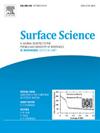Tuning the electronic and optical properties in MoSeS and WSeS monolayers by mechanical strains
IF 2.1
4区 化学
Q3 CHEMISTRY, PHYSICAL
引用次数: 0
Abstract
This study systematically explored the effects of tensile, compressive, and shear strains on the structural parameters, stability, and optoelectronic characteristics of MoSeS and WSeS monolayers, utilising first principles. Phonon spectral analysis confirms the dynamic stability of the MSeS (M=Mo, W) pristine and its biaxial tensile strain systems, and electronic structure calculations show that both MoSeS and WSeS are a type of direct bandgap semiconductor. Further analysis shows that different types of strains significantly affect the band edge, band gap width, band gap type, density of states, and charge density distribution. Uniaxial compressive strain has a greater effect on the electronic structure than uniaxial tensile strain, while the effect of shear strain is intermediate between uniaxial tensile and compressive, and biaxial strain has the greatest effect. The optical properties also get better when the material is strained. For example, under 16 % biaxial compressive strain, the static dielectric constants of MoSeS and WSeS increase by a factor of 6 and 9.6, respectively, which improves the dielectric properties and charge retention. Additionally, strain shifts the absorption band edges to longer wavelengths, expanding the material's response in the infrared and visible ranges. Compressive and shear strains also increase reflectivity, with MoSeS and WSeS reflectivity rising approximately 2.9 and 3.5 times, respectively, under 16 % biaxial compressive strain. These findings provide a theoretical basis for the application of Janus monolayers in novel optoelectronic devices and reveal a new strategy to precisely modulate optoelectronic properties through strain.

利用机械应变调节MoSeS和WSeS单层的电子和光学性质
本研究利用第一性原理系统地探讨了拉伸、压缩和剪切应变对MoSeS和WSeS单层结构参数、稳定性和光电特性的影响。声子谱分析证实了MSeS (M=Mo, W)原始体系及其双轴拉伸应变体系的动态稳定性,电子结构计算表明MoSeS和wse都是一种直接带隙半导体。进一步分析表明,不同类型的应变对带边、带隙宽度、带隙类型、态密度和电荷密度分布有显著影响。单轴压缩应变对电子结构的影响大于单轴拉伸应变,剪切应变的影响介于单轴拉伸和压缩之间,双轴应变的影响最大。当材料被拉伸时,其光学性能也会得到改善。例如,在16%的双轴压缩应变下,MoSeS和wse的静态介电常数分别增加了6倍和9.6倍,从而改善了介电性能和电荷保持率。此外,应变将吸收带边缘移动到更长的波长,扩大了材料在红外和可见光范围内的响应。压缩应变和剪切应变也增加了反射率,在16%的双轴压缩应变下,MoSeS和wse的反射率分别提高了约2.9倍和3.5倍。这些发现为Janus单层膜在新型光电器件中的应用提供了理论基础,并揭示了通过应变精确调制光电特性的新策略。
本文章由计算机程序翻译,如有差异,请以英文原文为准。
求助全文
约1分钟内获得全文
求助全文
来源期刊

Surface Science
化学-物理:凝聚态物理
CiteScore
3.30
自引率
5.30%
发文量
137
审稿时长
25 days
期刊介绍:
Surface Science is devoted to elucidating the fundamental aspects of chemistry and physics occurring at a wide range of surfaces and interfaces and to disseminating this knowledge fast. The journal welcomes a broad spectrum of topics, including but not limited to:
• model systems (e.g. in Ultra High Vacuum) under well-controlled reactive conditions
• nanoscale science and engineering, including manipulation of matter at the atomic/molecular scale and assembly phenomena
• reactivity of surfaces as related to various applied areas including heterogeneous catalysis, chemistry at electrified interfaces, and semiconductors functionalization
• phenomena at interfaces relevant to energy storage and conversion, and fuels production and utilization
• surface reactivity for environmental protection and pollution remediation
• interactions at surfaces of soft matter, including polymers and biomaterials.
Both experimental and theoretical work, including modeling, is within the scope of the journal. Work published in Surface Science reaches a wide readership, from chemistry and physics to biology and materials science and engineering, providing an excellent forum for cross-fertilization of ideas and broad dissemination of scientific discoveries.
 求助内容:
求助内容: 应助结果提醒方式:
应助结果提醒方式:


